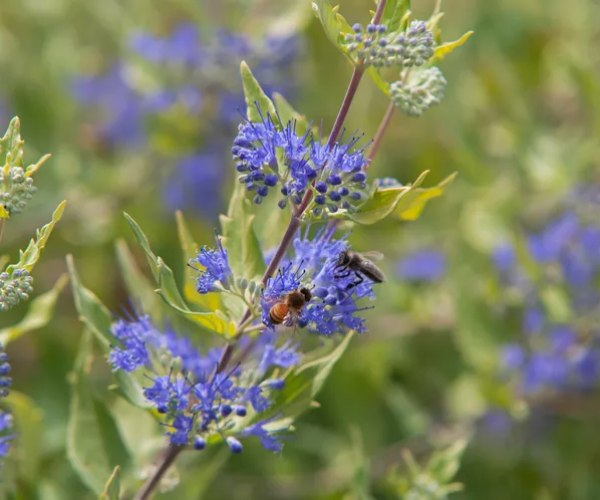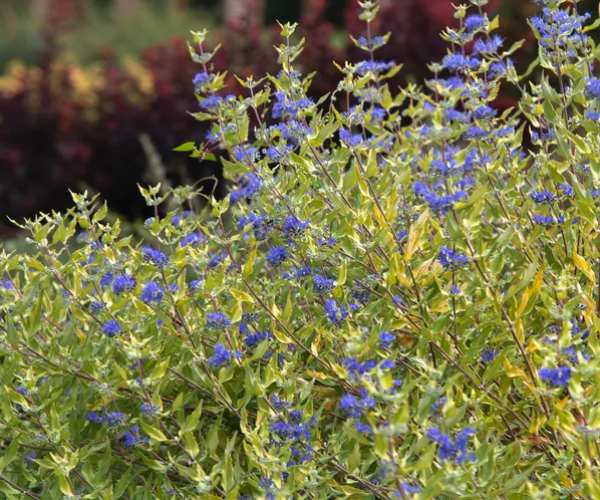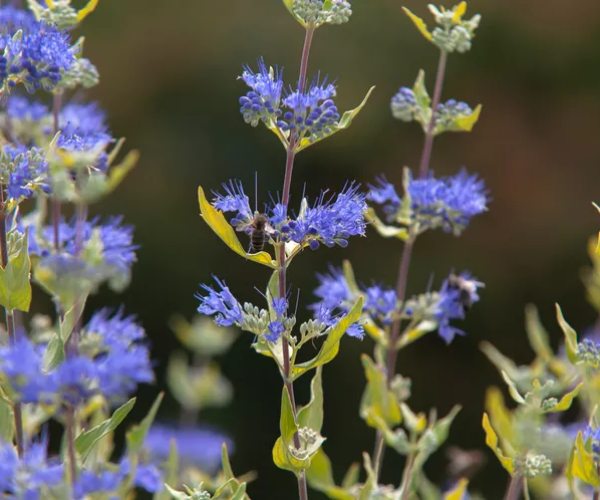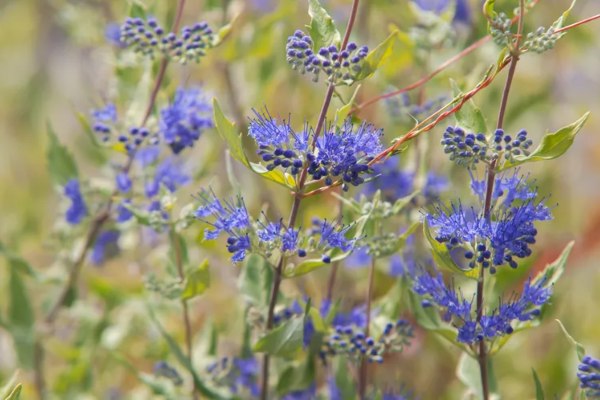Bluebeard or blue mist is one of the very few plants that produce true blue flowers. Scientifically known as Caryopteris x clandonensis, this plant is an accidental hybrid of C. incana and C. mongholica, and has since been a popular breed to produce several popular cultivars. No matter the size of the garden, the compact size and soft gray foliage of this plant make them a good choice.
These plants are either grown as deciduous shrubs or woody perennials that die back to the ground every winter, depending on the climate. Bluebeard grows from neat low mounds and produces narrow silvery-gray leaves resembling those of willow. During midsummer to fall, this plant produces small, pale blue flowers.
Plant Attributes
- Common Name: Bluebeard, blue mist, blue spirea
- Botanical Name: Caryopteris × clandonensis
- Family: Lamiaceae
- Plant Type: Shrub, perennial
- Mature Size: 2–4 ft. tall and wide
- Sun Exposure: Full
- Soil Type: Moist, well-drained
- Soil pH: Neutral
- Bloom Time: Summer, Fall
- Flower Color: Blue, purple, pink
- Hardiness Zones: 6-9 (USDA)
- Native Area: Asia
Bluebeard Care
Here are some of the main requirements needed for growing a Bluebeard plant:
- The best time to plant is in spring or fall, provided that your area doesn’t get too cold.
- It is necessary to plant Bluebeard in full sun and with medium-moisture soil which is required for them to thrive. That being said, they tolerate both drought and shade.
- Plant it in soil using compost or peat moss and you can also add vermiculite to provide ample drainage.
- Instead of chemical fertilizers, feed with organic matter.
Light
You should plant Bluebeard in full sun so that you get the best blooms. While they can tolerate partial shade, their flowering will somewhat be low. These plants may bloom later in the season if planted in a shady location.
Also, Read These are the Best Companion Plants for Roses!
Soil
Bluebeard loves a medium-moisture, well-draining soil. However, it thrives in moderately arid conditions once established. It can not stand wet, poorly drained soil. This plant thrives best with a neutral soil pH but can tolerate slightly acidic or slightly alkaline conditions.

Water
As mentioned above, Bluebeard plants can tolerate drought but it is necessary to water them regularly when they are young. Once established, they don’t require regular watering unless the season is particularly dry.
Temperature and Humidity
This plant is reliably hardy in USDA zones 6b to 9a; however, in the northern part of the range (zone 6), it may die back to ground level in winter. This is not an issue since this fast-growing shrub blooms on new growth from the current year.
Fertilizer
These plants are not lovers of heavy fertilizers. Therefore, some organic matter mixed into the planting hole is enough food for them. Side dressing with compost is better than chemical fertilizers for Bluebeard plants. If given too much fertilizers, it makes the plants leafy with fewer plants.
Types of Bluebeard
There are several types of Bluebeard commonly used in landscapes:
- Caryopteris x clandonensis: The original hybrid is one of the hardiest forms available and still one of the most popular.
- ‘Dark Knight’: This variety has the darkest blue flowers, but it is a bit more temperamental to grow.
- ‘Sunshine Blue’: This cultivar has deep blue flowers offset by yellow foliage.
- ‘Pink Chablis’: This Proven Winners introduction has pink flowers.
- ‘Longwood Blue’: This variety has sky-blue, fragrant blooms, silver-grey leaves, and a taller stature reaching about 4 feet high.
- ‘Worchester Gold’: This cultivar has golden foliage and lavender flowers.
Pruning
If you want to keep the plant in shape and keep flowering, cut them down by at least half in the early spring. Cutting them back to 12 to 18 inches won’t harm them at all. As the plant grows, you will notice some dead wood in the center. Prune it as needed.
This plant dying back is common in zones 6 and 7. When that happens, just remove the dead stalks in spring as new growth starts.
Propagating Bluebeard Plants
Bluebeard is a self-seeding plant and the volunteers can be transplanted as per your wish. It is also possible to propagate by softwood cuttings in the late spring. Here is how you can do it:
- Make sterilized pruners, rooting hormone, seedling pots, and an all-purpose potting mix ready.
- Using sharp pruners, cut 6-inch segments off new-growth stems.
- Cut off the lower pairs of leaves and dip the ends of the cuttings in the rooting hormone.
- Plant the cutting in pots filled with general-purpose potting mix.
- It is essential to keep the cuttings in bright indirect light and water them regularly until you notice they have developed good root systems. After that, they are ready to be planted in the landscape.
- While planting, ensure that the crown is at the level of the soil surface or slightly higher in a hole lined with organic matter for food and vermiculite for proper drainage. Since Bluebeard is slow to leaf out in the spring, do not worry if your plants look like dead twigs. Annually, they normally grow quickly, between 18 and 30 inches.
How to Grow Bluebeard from Seed
While we normally don’t plant Bluebeards from seeds because they are easier to propagate from stem cuttings, it is still possible. If you want to give it a try, follow these steps:
- Collect seeds from the seed pods in the late fall. Keep them in a plastic bag with damp sphagnum moss, and keep them in a refrigerator for three months.
- Sow the seeds 1/4-inch deep in pots filled with damp commercial potting mix in late winter.
- Keep the pots in a location that receives enough bright light at about 68 degrees Fahrenheit to germinate and sprout, and continue to grow them until planting time in spring.
If the growing season is long, your plants may bloom in their first growing season. The new seedlings must look a bit different from their mother plant, which is common when planting seeds from hybrid plants.
Potting and Repotting Bluebeard
Bluebeard has a compact growing habit and unique color and it has a compact growing habit. Having said that, it works well in large pots. It is recommended to plant it in a pot that has drainage holes that are twice as wide as the rootball using a combination of high-quality potting mix, compost, and sand. You can repot it once a year using a fresh growing medium.

Overwintering
Luckily, unlike most plants, Bluebeard doesn’t need particular winter protection. Just clear away plant debris from around its base to prevent fungi and pest larvae from overwintering. Some gardeners even prefer pruning it severely in the early winter rather than spring.
Remember to move the container plants to a covered porch or unheated garage for the winter. You can also place it inside an insulating silo.
Common Pests and Plant Diseases
Bluebeard can be prone to the fourline plant bug. While the foliage will mottle, it doesn’t affect the overall health of the plant and the bug moves on very quickly. If the bug remains intact, use insecticidal soap, horticultural oil, or neem oil to control them.
The only disease you should be aware of is crown rot, a fungal disease that sometimes occurs when Bluebeard is planted in dense, wet soil.
How to Get Bluebeard to Bloom
Basically, these plants bloom when they receive enough sun. However, overfertilizing can cause the plant to direct more and more energy into leaf production at the expense of flowers. If you notice your plant is not blooming adequately, try cutting back on whatever fertilizer or compost it is getting.
Bloom Months
These plants normally bloom in late summer to fall between July through September.
What do Bluebeard flowers look and smell like?
Bluebeard has an axillary cymes flower formation—starting at the end of the stems are clusters of fluffy, bright blue blooms, which look like mist or clouds of smoke. While Bluebeard is famous for its unique blue flowers, some varieties also produce pink and purple hybrids. The plant’s name comes from the base petals that look like a tuft of hair or beard.

The flower nectar attracts many pollinators like bees, hummingbirds, and butterflies. Birds prefer feeding on Bluebeard when the flower goes to seed during the fall. The blooms have a light, sweet smell and the leaves smell like eucalyptus.
How to encourage more blooms
Regular deadheading of the spent flower heads will help stimulate continued blooming.
FAQs
Q: What is the best way to use Bluebeard in the landscape?
A: The compact size and soft gray foliage make Bluebeard plants a good choice in any size garden in perennial borders, shrub borders, or as a small hedge plant. It is very effective planted en masse and is highly valued for its late summer flowers when few other shrubs are blooming.
Q: Are there other Caryopteris species I can try?
A: The C. x clandonensis hybrid is by far the most popular form of bluebeard, bred to be especially hardy. But there are several other species you may be able to find at specialty plant suppliers, including C. incana, C. divaricata, and C. nepalensis. All these plants are sold as bluebeard, so review the plant labels carefully to determine which species you are buying.
Q: How was this hybrid plant developed?
A: This award-winning plant was born entirely by accident. In 1930, an Englishman named Arther Simmonds attempted to propagate Caryopteris mongholica from gathered seeds. Unknown to him, a C. incana plant in the area cross-pollinated his plant, resulting in seeds that produced a brand-new bluebeard hybrid that eventually became the most popular of all Carypoteris varieties.
Also, Read Should You Add Banana Water and Eggshells to Your Plants? Experts Reveal!
